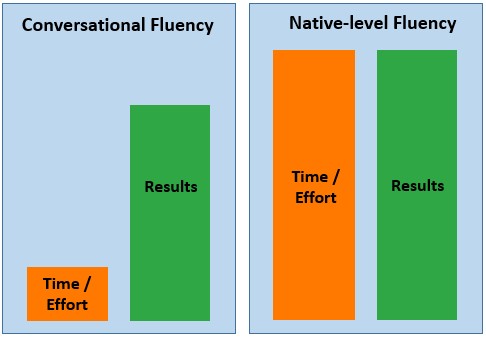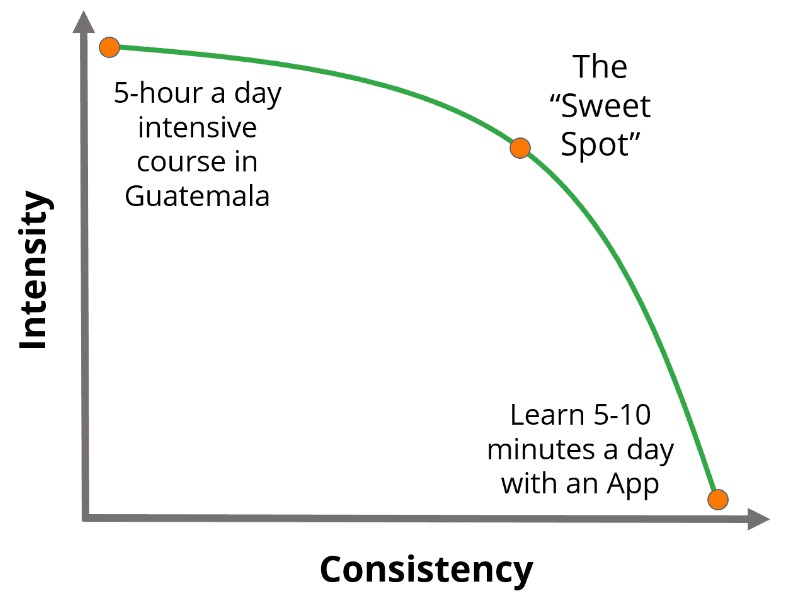How Fast Can Someone Learn Spanish? Achieving conversational fluency in Spanish typically takes around 8-12 months with consistent effort. At LEARNS.EDU.VN, we break down the factors influencing learning speed and offer practical strategies to accelerate your Spanish acquisition journey. Discover effective methods, personalized learning plans, and resources to master Spanish efficiently.
1. Understanding Spanish Fluency: What Does It Really Mean?
Fluency isn’t just about knowing words; it’s about effectively using them. Let’s explore the different levels of Spanish fluency to set realistic goals for your language learning journey.
1.1. Conversational Fluency: The Achievable Goal
Conversational fluency allows you to navigate everyday situations with ease.
- Comprehension: Understanding approximately 95% of spoken and written Spanish on common topics. You grasp the main ideas even in more complex discussions.
- Communication: Holding comfortable one-on-one conversations at a normal pace. Expressing your ideas clearly without excessive pausing or repetition.
- Pronunciation: Speaking with clear and accurate pronunciation, easily understood by native Spanish speakers.
This level of fluency is ideal for travel, communication with Spanish-speaking friends and family, and professional interactions. As Tim Ferris, the author of “The 4-Hour Workweek” noted, aiming for 95% comprehension provides significant benefits without the extensive effort required for near-native proficiency.
1.2. Native-Level Fluency: The Expert’s Domain
Native-level fluency represents the pinnacle of language mastery.
- Comprehension: Understanding nearly 100% of spoken and written Spanish, including nuances, jokes, and cultural references.
- Expression: Expressing yourself spontaneously and precisely in complex situations. Accurately conveying emotions and subtle shades of meaning.
- Pronunciation: Possessing perfect pronunciation, indistinguishable from a native speaker.
While impressive, achieving native-level fluency requires significant dedication. Most learners find conversational fluency more practical and rewarding.
2. Debunking Myths: How Long Doesn’t It Take to Learn Spanish
Be wary of unrealistic promises and outdated methods. Let’s address some common misconceptions about the time it takes to learn Spanish.
2.1. The “Learn Spanish in Days” Fallacy
Many language learning apps and courses promise fluency in just days or weeks. These claims often rely on exaggerated results and misleading marketing tactics. While these resources can be helpful, they are not magic bullets.
2.2. The Outdated Expert Opinion: FSI Estimates
The U.S. Foreign Services Institute (FSI) estimates that it takes approximately 600 classroom hours (or 1,200 total hours with independent study) to achieve conversational fluency in Spanish. This estimate is based on traditional classroom settings, which are not always the most efficient learning environments.
2.3. Why Traditional Methods Fall Short
- Inefficient Learning Environments: Traditional classrooms often involve passive learning and limited speaking practice.
- Academic Focus: Many programs prioritize academic knowledge over practical communication skills.
- Lack of Personalization: One-size-fits-all approaches don’t cater to individual learning styles and needs.
3. Optimizing Your Learning: Efficient Methods for Faster Progress
To learn Spanish faster, focus on active learning and real-world application. Let’s explore effective strategies to accelerate your progress.
3.1. Active Learning: Engaging Your Brain for Retention
According to research from the NTL Institute, active learning methods significantly improve retention.
- Practice Doing: Engaging in hands-on activities, such as conversations and role-playing.
- Immediate Use: Applying what you learn in real-world situations, such as ordering food or asking for directions.
3.2. Prioritizing Real-World Communication
Focus on speaking with native Spanish speakers as much as possible. This approach helps you develop practical communication skills and build confidence.
- Language Exchange Partners: Connect with native speakers who are learning your language.
- Spanish Meetups: Attend local events where you can practice speaking Spanish.
- Online Tutors: Work with a professional Spanish tutor for personalized instruction.
3.3. Immersive Learning: Creating a Spanish-Speaking Environment
Immerse yourself in the Spanish language and culture as much as possible. This approach helps you internalize the language and develop a natural feel for it.
- Listen to Spanish Music and Podcasts: Expose yourself to the sounds of the language.
- Watch Spanish Movies and TV Shows: Improve your comprehension and vocabulary.
- Read Spanish Books and Articles: Enhance your reading comprehension and grammar.
4. Balancing Intensity and Consistency: Finding Your Learning Rhythm
Finding the right balance between intensity and consistency is crucial for sustainable progress. Let’s explore how to optimize your learning schedule.
4.1. The Pitfalls of High Intensity, Low Consistency
Intensive study periods followed by long breaks can lead to rapid forgetting. The forgetting curve illustrates how information is lost over time without regular reinforcement.
4.2. The Drawbacks of Low Intensity, High Consistency
Studying for just a few minutes each day may not provide enough momentum for significant progress.
4.3. The Sweet Spot: One Hour Per Day
Aim for approximately one hour of focused Spanish study per day. This level of intensity is sustainable and allows for consistent progress.
5. Factors Influencing Learning Speed: What Affects Your Timeline?
Several factors can impact how quickly you learn Spanish. Understanding these factors can help you tailor your learning approach.
5.1. Prior Language Learning Experience
If you have experience learning other languages, you may find it easier to learn Spanish. You’ll likely have a better understanding of language learning concepts and strategies.
5.2. Motivation and Dedication
Your motivation and dedication play a significant role in your learning speed. The more motivated and dedicated you are, the more effort you’ll put into learning.
5.3. Learning Style and Resources
Your learning style and the resources you use can also affect your progress. Experiment with different methods and resources to find what works best for you.
5.4. Time Commitment and Consistency
The amount of time you dedicate to studying and how consistently you study will directly impact your learning speed.
5.5. Native Language Influence
Speakers of languages similar to Spanish, such as French or Italian, may find it easier to learn Spanish due to shared vocabulary and grammar structures.
6. A Realistic Timeline: How Long Will It Take You?
With consistent effort and the right approach, you can achieve conversational fluency in Spanish within a reasonable timeframe.
6.1. The 8-12 Month Estimate
If you dedicate an average of one hour per day to studying Spanish, you can expect to reach conversational fluency in approximately 8-12 months. This translates to roughly 250-350 hours of study time.
6.2. Sample Learning Schedule
Here’s a sample learning schedule for someone studying with a Spanish teacher:
| Day | Time | Activity |
|---|---|---|
| Monday | 8:00 – 9:00 PM | Spanish lesson |
| Thursday | 7:00 – 8:00 AM | Spanish lesson |
| Saturday | Morning | Homework and review |
| Every day | 10-15 minutes | Vocabulary practice with flashcard app |




6.3. Learning Without a Teacher
Learning independently is possible, but it requires more discipline and effort. Focus on conversation practice and consistent self-study.
7. Optimizing Your Spanish Learning Journey with LEARNS.EDU.VN
At LEARNS.EDU.VN, we offer a comprehensive approach to learning Spanish. Our resources, including personalized learning plans, expert guidance, and a supportive community, help you achieve conversational fluency faster and more effectively.
7.1. Personalized Learning Paths
LEARNS.EDU.VN provides customized learning paths that cater to your individual learning style, pace, and goals. By understanding your strengths and weaknesses, we create a tailored curriculum that maximizes your learning efficiency. This personalized approach ensures that you focus on areas where you need the most improvement, ultimately accelerating your progress.
7.2. Expert Guidance and Support
Our team of experienced Spanish instructors is dedicated to providing you with expert guidance and support throughout your learning journey. Whether you need help with grammar, pronunciation, or cultural nuances, our instructors are available to answer your questions and provide personalized feedback. This level of support ensures that you never feel lost or overwhelmed, and that you always have access to the resources you need to succeed.
7.3. Interactive and Engaging Resources
LEARNS.EDU.VN offers a wide range of interactive and engaging resources, including video lessons, audio exercises, quizzes, and cultural insights. These resources are designed to make learning Spanish fun and enjoyable, while also helping you develop practical communication skills. By immersing yourself in the Spanish language and culture, you’ll gain a deeper understanding of the language and be more motivated to continue learning.
7.4. Community Support
Connect with fellow Spanish learners from around the world through our online community. Share your experiences, ask questions, and practice your Spanish with others who are on the same journey. This supportive community provides a sense of camaraderie and encouragement, helping you stay motivated and committed to your learning goals.
8. Essential Tools and Resources: Building Your Spanish Arsenal
Equipping yourself with the right tools and resources can significantly enhance your learning experience.
8.1. Language Learning Apps
- Duolingo: A gamified app for building vocabulary and basic grammar skills.
- Memrise: Uses spaced repetition to help you memorize words and phrases.
- Babbel: Offers structured courses with a focus on conversational skills.
8.2. Online Dictionaries and Translators
- WordReference: A comprehensive online dictionary with example sentences and forum discussions.
- Google Translate: A quick and easy tool for translating words and phrases.
- Linguee: Provides contextual translations and example sentences from authentic sources.
8.3. Spanish Language Exchange Platforms
- HelloTalk: Connect with native Spanish speakers for language exchange.
- Tandem: Find language partners and practice speaking Spanish.
- italki: Offers professional online Spanish lessons and language exchange opportunities.
8.4. Grammar Resources
- SpanishDict: Offers comprehensive grammar explanations and practice exercises.
- StudySpanish.com: Provides interactive grammar lessons and quizzes.
- Real Academia Española (RAE): The official source for Spanish language rules and definitions.
9. Overcoming Challenges: Staying Motivated and Focused
Learning a new language can be challenging, but with the right strategies, you can stay motivated and overcome obstacles.
9.1. Setting Realistic Goals
Set achievable goals and celebrate your progress along the way. Break down your learning into smaller, manageable steps.
9.2. Finding a Learning Buddy
Partner with a friend or fellow learner to stay accountable and motivated.
9.3. Varying Your Learning Activities
Keep your learning fresh and engaging by mixing up your activities. Incorporate different resources and methods to avoid boredom.
9.4. Celebrating Your Successes
Acknowledge and celebrate your accomplishments, no matter how small. This helps you stay motivated and reinforces your progress.
9.5. Don’t Be Afraid to Make Mistakes
Embrace mistakes as part of the learning process. Don’t let the fear of making errors hold you back from speaking.
10. Common FAQs: Your Questions Answered
Let’s address some frequently asked questions about learning Spanish.
10.1. Is Spanish hard to learn?
The Foreign Service Institute (FSI) classifies Spanish as a Category I language, meaning it’s considered one of the easier languages for native English speakers to learn. This is due to its relatively straightforward grammar and pronunciation, as well as its many cognates (words with similar origins and meanings) with English. However, like any language, mastering Spanish requires consistent effort and dedication.
10.2. What’s the best way to learn Spanish fast?
The fastest way to learn Spanish involves a combination of intensive study, active learning, and real-world practice. Prioritize speaking from day one, immerse yourself in the language as much as possible, and seek out opportunities to interact with native speakers.
10.3. How many hours a day should I study Spanish?
Aim for at least one hour of focused Spanish study per day. This allows for consistent progress without overwhelming yourself.
10.4. Can I become fluent in Spanish in 3 months?
While it’s possible to make significant progress in 3 months, achieving full conversational fluency typically takes longer. However, with intensive study and immersion, you can reach a basic level of fluency in this timeframe.
10.5. What are the most common mistakes Spanish learners make?
Common mistakes include misusing verb conjugations, mixing up “ser” and “estar,” and using incorrect gender agreements. Pay close attention to these areas and practice regularly to avoid these errors.
10.6. How can I improve my Spanish pronunciation?
Listen to native Spanish speakers and try to mimic their pronunciation. Record yourself speaking and compare it to native speakers to identify areas for improvement. Consider working with a Spanish tutor who can provide personalized feedback.
10.7. Is it better to learn Spanish online or in person?
Both online and in-person learning have their advantages. Online learning offers flexibility and convenience, while in-person classes provide a structured learning environment and opportunities for face-to-face interaction. Choose the option that best suits your learning style and preferences.
10.8. What are the best resources for learning Spanish grammar?
Some excellent resources for learning Spanish grammar include SpanishDict, StudySpanish.com, and the Real Academia Española (RAE).
10.9. How can I stay motivated while learning Spanish?
Set realistic goals, find a learning buddy, vary your learning activities, and celebrate your successes. Remember why you started learning Spanish and focus on the benefits it will bring to your life.
10.10. What should I do if I get stuck or feel discouraged?
Don’t be afraid to ask for help from a tutor, language partner, or online community. Take a break if you need to, and come back to your studies with a fresh perspective. Remember that learning a language is a journey, and it’s okay to have ups and downs along the way.
Learning Spanish is an enriching experience that opens doors to new cultures, opportunities, and connections. By following these tips and strategies, you can accelerate your learning journey and achieve your Spanish language goals. Remember that consistency, dedication, and a positive attitude are key to success. With the resources and support available at LEARNS.EDU.VN, you can confidently embark on your path to Spanish fluency.
Ready to start your Spanish learning journey? Visit learns.edu.vn today to explore our personalized learning plans, expert guidance, and interactive resources. Let us help you achieve your language goals faster and more effectively. Contact us at 123 Education Way, Learnville, CA 90210, United States or WhatsApp at +1 555-555-1212. We’re here to support you every step of the way!